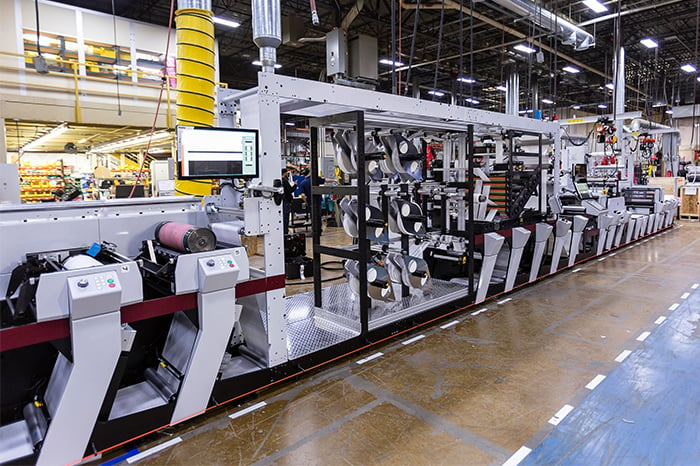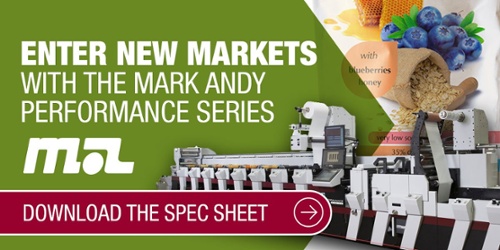RFID Technology, Innovative Labels and the Shops of Future
Picture this: automation in retail. Stores with no staff. No lines, registers, or cashiers, only smartphones. Consumers can purchase mainly food products, but also cleaning items and cosmetics. Beverages of all kinds, sweets, healthy snacks, ready-to-eat meals as well as cooled dairy, and even sausages are readily available. And every product is marked with a special RFID tag, enabling this futuristic reality, enabling an automated sales process.
“This is not science-fiction, it’s an existing shop in our country, Poland, with additional stores preparing to follow suit and open as well,” says Lukasz Chruslinski, Sales Manager Mark Andy. Monitoring the ebbs and flows of worldwide printing trends, Mark Andy has noticed an uptick in demand for printing presses with RFID modules. A twist on the existing, mainstay RFID application has made a splash in the world of packaging and labels. Chruslinski continues “Many ask ‘what’s next?’ in the printing industry, and with CAGR growth is holding steady, RFID labels are certainly one of many avenues our technology partners and customers are exploring.”

While the technology is not new, the use of RFID (radio frequency identification) in our day-to-day life continues to grow. For example, various industries from laundry to hotel and of course warehouses have been using RFID tags for years. “RFID enables reading and sending data, as well as electronic charging of chips containing these data,” explains Lukasz Chruslinski. He continues “These traditional uses are still prevalent ad continue to provide end-users additional insight and control of industrial processes, manufacturing, logistics, warehousing, access control, safety management and beyond.”
Where trends are evolving is the implementation of RFID technology into next tier use regarding automation. Elaborating on his personal and professional experience, Chruslinski goes on to share that some shops in Poland, including a popular sports chain, have already successfully used this technology to become a “smart store.” RFID labels allow customers to make self-service shopping, reducing the time of purchasing process and bringing economical benefits for retail stores, through inventory management (a traditional use of RFID) as well as reducing the number of employees needed (a new trend found through RFID labels). “The whole process is very simple – a tagged label (containing information about a product) is moved to a reader and a system takes care of the rest,” says Chruslinski.
However, opportunities brought by this technology are much bigger. “The approach can be much more creative,” Chruslinski continues. “The best example is using RFID in fitting rooms. On one hand, this solution provides the known value by decreasing the likelihood that a product from stealing. But something newer we’re seeing RFID labels be used for is providing the end-user, or the consumer, more information about the product.
What exactly does that mean and how does it work? RFID readers are becoming more accessible. Consumers scan the RFID tag and after getting data, the readers provide additional information on a special screen, including its properties, versions, colors, sizes, or pricing. Moreover, they also allow for a better user experience by providing ideas for using a given product in specific stylizations. These UX properties are also being shown to drive additional revenue for retailers by incorporating other products from the same shop in their recommendations. Ultimately, RFID labels have the ability to help customers convert to sales while also increasing the average purchase amount per buyer.”
.png)
RFID technology is also more and more commonly used by grocery shops. “In Poland, some of them are testing it currently,” says Lukasz Chruslinski. He continues “For example, when a customer enters the shop with a list of “missing” products in his smartphone (sent by an “intelligent” fridge), the data is touchless read and a system summarizes and processes the shopping. This is how the world may look in the near future and the companies prepared for these changes will be the winners.”
It also concerns label producers. RFID tags, known also as transponders or chips, are small data carriers, produced in different shapes and sizes. They contain information needed by manufacturers, suited to users’ expectations. “All this information will be placed in a label of future,” Chruslinski adds, “Mark Andy offers presses enabling the production of such labels, using narrow webs with tags, opening completely new opportunities for manufacturers and printing houses. They can be used to bring information about a purchased product to the customer – a manual, expiry date, current ownership and many more. It will secure from stealing and counterfeiting. It also will bring us “best before” information (in case of products stored in a fridge) or a guarantee for a product we buy”.

RFID technology is also used in the pharmaceutical industry. “Every year hundreds of medicaments are withdrawn from the market. Most of the announced withdrawals force a medical store having these drugs (e.g. hospital pharmacy) to make some actions. It must specify if it will use the medicament or not. If not, the medicament must be localized and removed to make sure it will not be sold or dosed to any patient,” Chruslinski elaborates. Similar actions must be initiated in case of products with an expired date of usage. Thanks to RFID technology, removing them from the market is very simple and much quicker. It reduces manual processes, amount of work needed for some actions, helps in eliminating errors in sets, positively influencing the safety of patients and pharmacy customers. Therefore, this solution will be much more prevalent in our life in the not too distant future.
As Mark Andy underlines, a modern warehouse will not be able to function anymore without this kind of information, delivered as barcodes or tags. ID technologies help in quicker completing and getting the products. Additionally, a perfect distribution is guaranteed. Thanks to RFID, we shorten the time of implementing new employees, and the goods will be placed closer to a place of issuing. If the supply chain is set up correctly, we can also reduce storage space.
“RFID technology is also used by parcel suppliers, for example when sorting them” Chruslinski finishes. He rounds out his forecast by sharing “It enables a touchless identification of letters and packs from several meters, speeding the work process and making it easier.”
“The solution widely enters many areas of our life and becomes more and more popular. So we warmly invite printers and all other companies interested in this technology to contact us. We will be happy to share our knowledge and experience with them” Lukasz Chruslinski concludes.
